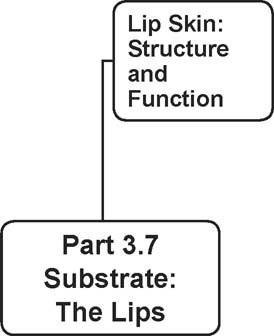THE LIPS

PART 3.7
LIP SKIN: STRUCTURE AND FUNCTION
Author
Philip Wertz, Ph.D.
Dows Institute
University of Iowa
Iowa City IA 52242 USA
ABSTRACT
The lips are covered by a thin keratinized epithelium layer on a flexible, connective tissue with a rich blood supply. The stratum corneum on the vermillion zone of the lip contains the same types of ceramides, cholesterol, and fatty acids found in other regions of epidermis, but the barrier function is weak, permitting a relatively high TEWL. There are sebaceous follicles in the connective tissue that supply sebaceous lipids to the lip surface. The morphology of the lips changes abruptly with increasing age.
3.7.1 Vermilion zone/vermilion border
3.7.1 VERMILION ZONE/VERMILION BORDER
The lips represent a specialized transitional region in going from the skin to the oral mucosa. The line where the facial skin meets the surrounding the red external lip is known as the vermilion border of the lip. This term has frequently been misused to refer to the entire external red portion of the lip. The entire external red portion of the lip is referred to as the vermilion or vermilion zone. This vermillion zone has an underlying connective tissue that is more flexible than the connective tissue of most regions of the skin and is covered by a thin orthokeratinized epithelium [1]. The underlying connective tissue has a rich blood supply, which contributes to the red coloration [2].
The projected area of the corneocytes on the vermillion zone of the lip is slightly larger than that of corneocytes from the cheek, and the TEWL through the lip is greater than TEWL through the cheek [3]. The transition from the exterior keratinized epithelium of the vermillion zone and the internal nonkeratinized epithelium is abrupt; however, the portion of the vermilion zone closest to the oral mucosa is sometimes referred to as the submucosa. Surprisingly, the hydration of the submucosa is less than the rest of the external vermillion zone [4]. Hydration of the upper lip is significantly greater than hydration of the lower lip.
Stay updated, free articles. Join our Telegram channel

Full access? Get Clinical Tree








